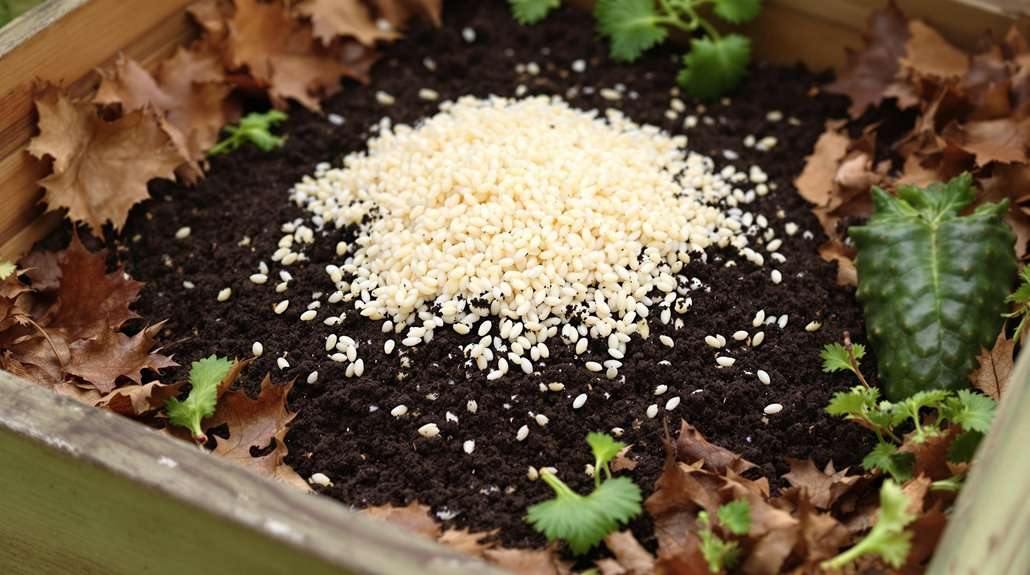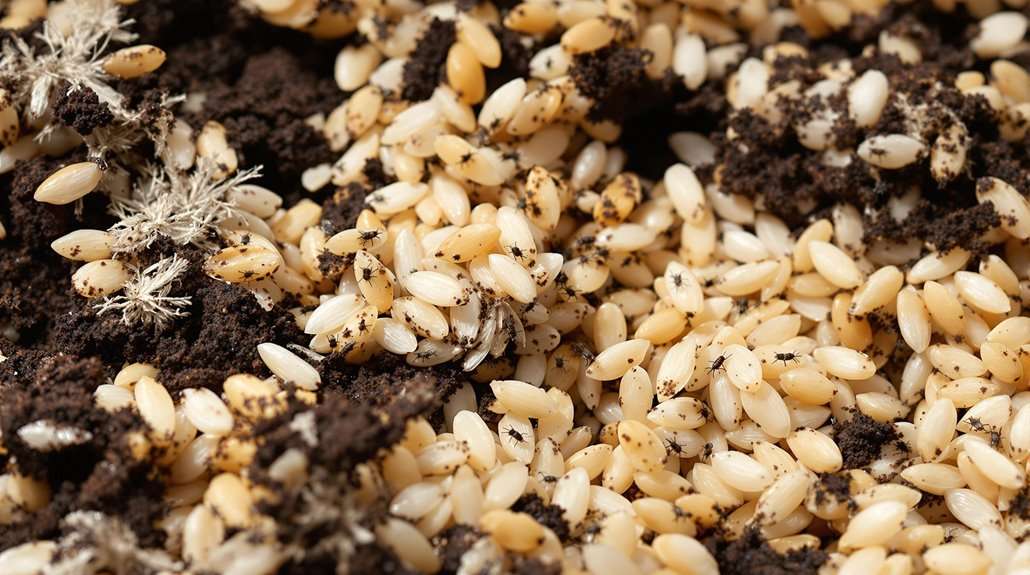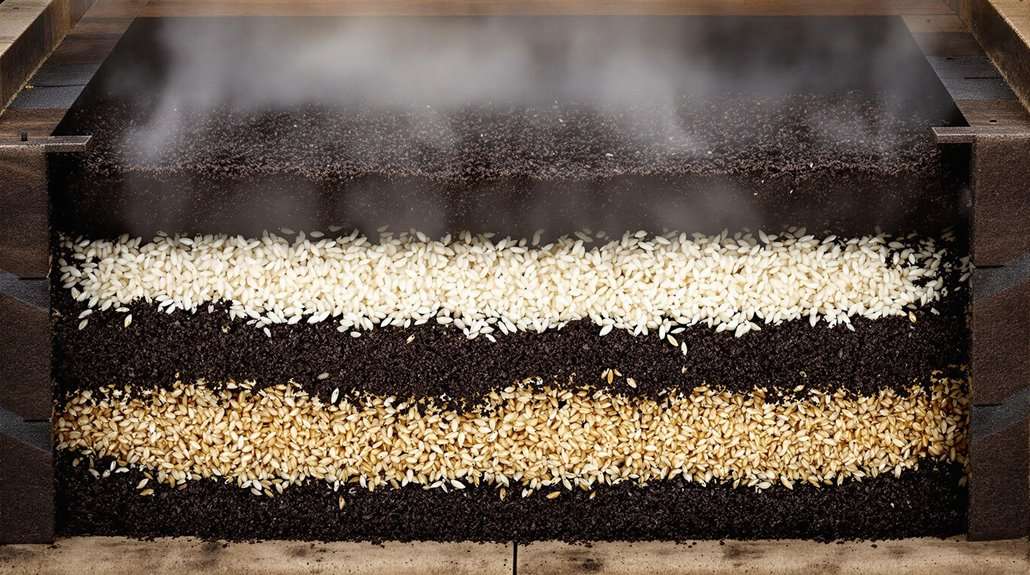Can You Compost Rice
You can safely compost both cooked and uncooked rice using several effective methods, including hot composting, vermicomposting, and bokashi fermentation. To succeed, maintain a 1:3 ratio of greens (rice) to browns (dry leaves, straw), and keep your compost pile at 130-160°F with moisture levels similar to a wrung-out sponge. While composting rice carries risks like pest attraction and bacterial growth, you'll minimize these issues by adding rice in small quantities, covering it well, and ensuring proper aeration through regular turning. The process takes 1-3 months for cooked rice and 2-6 months for uncooked rice, with careful monitoring leading to rich, nutrient-dense compost for your garden.
This post may contain affiliate links. If you make a purchase through these links, I may earn a commission at no additional cost to you. Additionally, portions of this post may be generated using artificial intelligence (AI) technology. While we strive for accuracy, please be aware that AI-generated content may not always be perfect and should be fact-checked when necessary.
The Spatula Scoops
- Both cooked and uncooked rice can be composted effectively when mixed with other organic materials in proper ratios.
- Use a 1:3 ratio of rice (green material) to brown materials like dry leaves and straw for successful decomposition.
- Hot composting and vermicomposting are effective methods, with cooked rice breaking down in 1-3 months and uncooked in 2-6 months.
- Cover rice with brown materials and maintain proper moisture levels to prevent pest infestations and foul odors.
- Monitor compost temperature between 130-160°F and turn regularly to ensure proper decomposition and prevent bacterial growth.
Understanding Rice Composting Basics

If you've ever wondered whether rice can go into your compost bin, you're in luck. Rice composting is a sustainable way to recycle your leftover grains, whether cooked or uncooked, through a controlled decomposition process that transforms food waste into nutrient-rich soil.
To succeed with rice composting, you'll need to understand the fundamental balance of materials. You should maintain a 1:3 ratio of greens (including your rice and vegetable scraps) to browns (such as dry leaves and straw). The process relies heavily on proper environmental conditions, where you'll want to keep your compost pile as damp as a wrung-out sponge and maintain temperatures between 130-160°F. You'll also need to guarantee adequate oxygen flow by turning your pile regularly. Adding layers of manure to your rice compost can significantly improve the decomposition process and final nutrient content.
The secret to effective rice composting lies in managing the carbon-to-nitrogen ratio. Since rice is high in carbon, you'll want to mix it with nitrogen-rich materials like food scraps or manure. Remember that cooked rice breaks down more quickly than uncooked rice, which typically takes about three months to decompose under ideal conditions.
Best Methods For Composting Rice
Choosing the right composting method for rice can greatly impact your success and efficiency in recycling this common kitchen staple. You'll find four primary methods that each offer unique advantages: hot composting, vermicomposting, Bokashi, and closed bin systems.
Hot composting proves effective when you maintain temperatures between 130-160°F, requiring you to hydrate uncooked rice before adding it to your pile. Mixing rice with carbon-rich materials helps achieve optimal decomposition. If you're interested in vermicomposting, you'll want to focus on using cooked rice, as worms process it more efficiently. The Bokashi method offers a distinctive approach, using specialized inoculants to ferment your rice through an anaerobic process, while producing useful liquid fertilizer as a bonus. For those concerned about pests, a closed bin system provides excellent protection while allowing you to compost both cooked and uncooked rice.
Whichever method you choose, you'll need to maintain proper balance by mixing rice with other materials. Remember to turn your compost regularly and monitor moisture levels. Each approach requires specific maintenance, but they all lead to the same valuable end product: nutrient-rich compost for your garden.
Key Risks To Watch For

While composting rice can be rewarding, you'll need to stay alert to several key risks that could derail your efforts. The most significant concerns you'll face are pest infestations, bacterial growth, and unpleasant odors, all of which can compromise your compost's quality.
You'll find that both cooked and raw rice can attract unwanted visitors to your compost pile. Rodents and other pests are particularly drawn to cooked rice, which can lead to serious infestation issues if not properly managed. When it comes to bacterial concerns, you'll need to watch for excessive moisture and poor aeration, as these conditions can create an unhealthy anaerobic environment that promotes harmful bacterial growth and mold formation. Wearing protective gloves and masks is essential when handling moldy rice to prevent exposure to harmful mycotoxins.
Foul odors are another risk you'll need to monitor closely. These typically develop when there's insufficient aeration or an imbalance in your compost ingredients. To minimize these risks, you'll want to guarantee proper moisture management, maintain adequate aeration, and carefully balance your green and brown materials. Consider using hot composting methods, which can help break down rice more effectively while reducing potential problems.
Making The Most Of Rice
The successful composting of rice requires strategic planning and proper execution to maximize its benefits. To get the most value from your rice waste, you'll want to implement proper layering techniques and maintain ideal moisture levels throughout the composting process.
Start by mixing your rice with a balanced combination of carbon-rich materials, like dried leaves or newspaper, and nitrogen-rich components such as vegetable scraps. You'll achieve the best results by adding rice in small quantities and covering it with other materials to discourage pest activity. If you're working with uncooked rice, consider soaking it first to enhance moisture distribution and speed up decomposition. A moisture level of 40-60 percent is optimal for effective rice composting.
For maximum nutrient benefits, turn your compost pile regularly to prevent rice from clumping and guarantee proper aerobic breakdown. You can choose between hot composting, which accelerates decomposition through heat generation, or Bokashi composting, which ferments the rice in a controlled environment. Both methods will help you create nutrient-rich compost that improves soil structure, enhances microbial activity, and provides essential nutrients for your plants' growth and development.
Time And Temperature Factors

To achieve these conditions, you'll want to regularly turn your compost pile and monitor its temperature. During summer months, decomposition will speed up naturally, while winter's cooler temperatures will slow the process. You can accelerate decomposition by practicing hot composting, where temperatures reach up to 160°F, effectively killing unwanted bacteria and weed seeds.
Managing your pile's heat requires a careful balance of green materials (like cooked rice) and brown materials (such as uncooked rice). Don't forget to maintain proper aeration through regular turning, as this prevents anaerobic conditions that can lead to unpleasant odors and harmful pathogens. If you notice temperature fluctuations, adjust your turning schedule and consider adding hydrated white lime to regulate both temperature and pH levels.
Frequently Asked Questions
Can Leftover Rice With Sauces or Seasonings Be Added to Compost?
You'll want to avoid adding rice with sauces or seasonings directly to your compost pile. These additions can attract pests, create unpleasant odors, and disrupt the composting process. If you're determined to compost seasoned rice, rinse it thoroughly first to remove sauces and seasonings. Then, bury the cleaned rice in the center of your hot compost pile, mixing it with plenty of brown materials for proper decomposition.
How Much Rice Should Be Added to a Compost Bin at Once?
You'll want to limit rice additions to about 1-2 cups per week for a standard-sized home compost bin (3x3x3 feet). Mix the rice thoroughly with other materials, maintaining the 3:1 ratio of brown to green materials. If you're adding cooked rice, spread it thinly and bury it 6-12 inches deep in your pile. Don't exceed 10% of your total weekly compost additions with rice.
Does Basmati Rice Decompose Differently Than Other Rice Varieties?
Basmati rice doesn't decompose differently from other rice varieties in your compost bin. While basmati has its unique characteristics for cooking, its decomposition process follows the same pattern as other rice types. You'll find that factors like moisture content, temperature, and whether the rice is cooked or uncooked have far more impact on decomposition than the specific variety you're composting.
Can Rice Water Be Used to Enhance the Composting Process?
You can definitely use rice water to enhance your composting process, as it's rich in nutrients like nitrogen, phosphorus, and potassium. When you add rice water to your compost pile, you'll boost microbial activity and speed up decomposition. Mix it with your brown materials to maintain proper moisture levels, but don't oversaturate the pile. For best results, use the water within 24 hours of cooking, while its nutrients are most potent.
Should Rice Be Rinsed Before Adding It to the Compost Pile?
You'll want to rinse your rice before adding it to your compost pile, as if you're preparing it for a gourmet meal. This vital step removes oils, spices, and excess moisture that could attract unwanted pests or create unpleasant odors. For cooked rice, a thorough rinse eliminates food residues that might disrupt the composting balance, while raw rice needs minimal rinsing. Remember to use cool water to preserve beneficial microbes.





